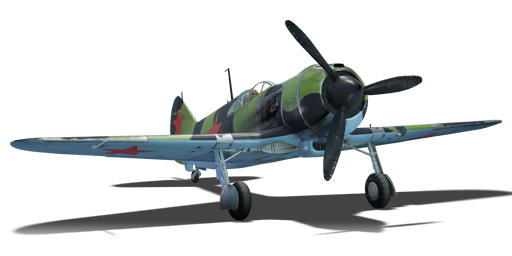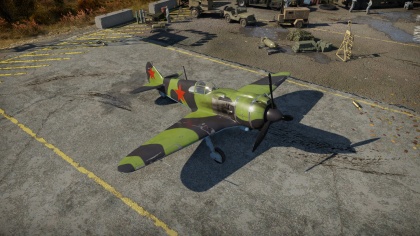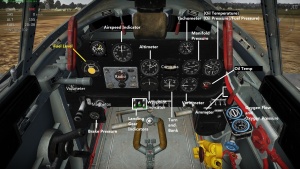La-5
Contents
Description
The La-5 is a Rank II Soviet fighter with a battle rating of 3.3 (AB) and 3.0 (RB/SB). It was introduced in Update 1.35.
The La-5 is best used as a energy fighter. While having decent maneuverability, it cane be found sluggish at low speeds, and suffers from control surfaces locking up at higher speeds. It is best to gain altitude, stay around 2-3000 meters and make short dives on distracted or weaker enemy planes.
General info
Flight Performance
| Characteristics | |||||||
|---|---|---|---|---|---|---|---|
| Stock | |||||||
| Max Speed (km/h at 6,200 m) |
Max altitude (meters) |
Turn time (seconds) |
Rate of climb (meters/second) |
Take-off run (meters) | |||
| AB | RB | AB | RB | AB | RB | ||
| 551 | 537 | 9,600 | 22.6 | 23.2 | 7.5 | 9.7 | 370 |
| Upgraded | |||||||
| Max Speed (km/h at 6,200 m) |
Max altitude (meters) | Turn time (seconds) | Rate of climb (meters/second) |
Take-off run (meters) | |||
| AB | RB | AB | RB | AB | RB | ||
| 606 | 573 | 9,600 | 19.7 | 21.1 | 22.6 | 13.6 | 370 |
Details
| Features | ||||
|---|---|---|---|---|
| Combat flap | Take-off flap | Landing flap | Air brakes | Arrestor gear |
| ✓ | ✓ | ✓ | X | X |
| Limits | ||||
|---|---|---|---|---|
| Wing-break speed (km/h) |
Gear limit (km/h) |
Combat flap (km/h) |
Max Static G | |
| + | - | |||
| 700 | 340 | 450 | ~20 | ~20 |
| Optimal velocities | |||
|---|---|---|---|
| Ailerons (km/h) |
Rudder (km/h) |
Elevators (km/h) |
Radiator (km/h) |
| < 410 | < 400 | < 430 | > 200 |
| Compressor (RB/SB) | ||
|---|---|---|
| Setting 1 | ||
| Optimal altitude | 100% Engine power | WEP Engine power |
| 2,050 m | 1,540 hp | 1,870 hp |
| Setting 2 | ||
| Optimal altitude | 100% Engine power | WEP Engine power |
| 5,400 m | 1,330 hp | ?,??? hp |
Survivability and armour
- 8.5 mm Steel - Plate behind the pilot
- 8.5 mm Steel - Headrest
- No armour glazing
- Critical components located at front of aircraft (fuel, pilot, engine, controls)
Armaments
Offensive armament
The La-5 is armed with:
- 2 x 20mm ShVAK cannons, nose mounted (170 rpg = 340 total)
Suspended armament
The La-5 has two options when it comes to external ordinance:
- Without load
- 2 x 50 kg FAB-50 bombs (100 kg total)
Usage in the battles
At the start of the game, climb high and wait for the initial dogfight to commence. Once the other planes are engaged, dive on one, fire a good burst, and pull away back to around 3000 m, and do it again. This will be conducted at a lower altitude than typical boom and zoom aircraft, but here is where the plane's speed will be optimal for maneuverability. If you pick up a tail, speeds of around 300 kph/186.4 mph is the best for manoeuvering. This plane is one of the first Soviet fighters in the game to have a powerful engine, WEP, and effective cooling.
The 20 mm cannons are very powerful, but low on ammo. Only fly this plane after getting used to the trajectories of the other more forgiving Soviet planes, such as the Yak line, since they use the same cannons. It is typically best to use Ground Target ammo for its high explosive properties.
Manual Engine Control
| MEC elements | ||||||
|---|---|---|---|---|---|---|
| Mixer | Pitch | Radiator | Supercharger | Turbocharger | ||
| Oil | Water | Type | ||||
| Controllable | Not controllable | Not controllable | Not controllable | Separate | Not ontrollable | Not controllable |
Modules
| Tier | Flight performance | Survivability | Weaponry |
|---|---|---|---|
| I | Fuselage Repair, Radiator | DZ-40 | |
| II | Compressor | Airframe | |
| III | Wing Repair, Engine | Rear Armor Plate | Offensive 20 mm |
| IV | Engine Injection | Cover | New 20 mm Cannons |
Pros and cons
Pros:
- Excellent performance at 3,000 m/9,843 ft
- Good performance in both vertical and horizontal flight
- Good energy retention
- Nose mounted weaponry
- Leading edge slats
- High rate of fire of the 20 mm ShVAK cannons
Cons:
- Poor performance above 3000 m/10,000 ft
- Low total ammunition count
- Jack of all trades master of none
- Severe surface control compression in dives
- No bulletproof glass or armour to protect the pilot in head on attacks
History
In early 1942, Semyon Lavochkin's LaGG-3 fighter was under threat of having its production cancelled, having proved itself to be a flawed fighter, under powered and overweight. At the same time, Arkady Shvetsov was faced with a lack of demand for his M-82 radial engine, only successfully used by the Sukhoi Su-2 ground attack aircraft that was also in danger of being cancelled. The two designers met at a conference in Moscow, and Shvetsov agreed to help Lavochkin fit the M-82 engine to the LaGG-3 air frame. Mikhail Gudkov, one of the original designers of the LaGG-3, had already attempted to do the same thing, resulting in the Gu-82 fighter. However, he had delayed too long in getting the fighter into production and by April 1942, Aleksander Yakovlev had succeeded in getting production of the LaGG-3 cancelled in favour of his Yak-7 fighter, effectively monopolizing Soviet fighter production.
Lavochkin's OKB was, in the meantime, transferred to the backwaters of Tbilisi, Georgia and he and his team had to work almost illegally and in harsh conditions to modify the LaGG-3 for the M-82 engine. The radial engine was wider than the LaGG-3 fuselage cross section, requiring skirting to attach the engine to the fuselage, and the M-82 also had no space for an engine-mounted cannon, unlike the Klimov M-105. Thus, the armament was changed to two 20 mm ShVAK cannon mounted on top of the engine. The new LaGG-3 M-82 (also known as the Samolyot 37 (Aircraft 37) or the Type 37) was completed in February 1942 and underwent test flights, with promising results despite problems with engine cooling. Its performance was better than any Soviet fighter then in service. Other problems were also revealed in testing: excessive control forces, oil leaks, and excessive weight, but these could not overshadow the LaGG-3 M-82's excellent performance, and it was ordered into full-scale development as the LaG-5. The first fully operational LaG-5s were delivered on 20 June 1942.
Series LaG-5s suffered from poor workmanship, which reduced performance considerably. As was revealed in the test flights, pilots found it to be a more difficult aircraft to fly than the Yak-1 or LaGG-3, but the radial engine enhanced protection during head-on attacks. Redesignated La-5 in September 1942, the new fighter faced its first serious test during the battle of Stalingrad. It proved not to be enough to equal the Bf 109 F-4 and G-2 models, but was considered capable of further improvement. Continuous improvements to the La-5 would eventually lead to the La-5F, La-5FN, and finally the La-7, among some of the finest Soviet fighters of the Great Patriotic War.
Media
An excellent addition to the article will be video guides, as well as screenshots from the game and photos.
Read also
Links to the articles on the War Thunder Wiki that you think will be useful for the reader, for example,
- reference to the series of the aircraft;
- links to approximate analogues of other nations and research trees.
Sources
Paste links to sources and external resources, such as:
- topic on the official game forum;
- page on aircraft encyclopedia;
- other literature.
| USSR fighters | |
|---|---|
| I-15 | I-15 WR · I-15 M-22 · I-15 M-25 · I-15bis · Krasnolutsky's I-15bis |
| I-153 M-62 · Zhukovsky's I-153-M62 · I-153P | |
| I-16 | I-16 type 5 · I-16 type 10 · I-16 type 18 · I-16 type 24 · I-16 type 27 · I-16 type 28 · I-180S |
| I-29 | I-29 |
| I-185 | I-185 (M-71) · I-185 (M-82) |
| I-225 | I-225 |
| ITP | ITP (M-1) |
| MiG-3 | MiG-3-15 · MiG-3-15 (BK) · MiG-3-34 |
| LaGG | I-301 · LaGG-3-4 · LaGG-3-8 · LaGG-3-11 · LaGG-3-23 · LaGG-3-34 · LaGG-3-35 · LaGG-3-66 |
| La | La-5 · La-5F · La-5FN · La-7 · Dolgushin's La-7 · La-7B-20 · La-9 · La-11 |
| Yak-1/7 | Yak-1 · Yak-1B · Yak-7B |
| Yak-3 | Yak-3 · Eremin's Yak-3(e) · Yak-3P · Yak-3T · Yak-3U · Yak-3 (VK-107) |
| Yak-9 | Yak-9 · Yak-9B · Golovachev's Yak-9M · Yak-9T · Yak-9K · Yak-9U · Yak-9UT · Yak-9P |
| Other countries | ▂P-40E-1 · ▂P-47D-27 · ▂Hurricane Mk IIB · ▂Fw 190 D-9 · ▂Spitfire Mk IXc |
| P-39 | ▂P-39K-1 · ▂Pokryshkin's P-39N-0 · ▂P-39Q-15 |
| P-63 | ▂P-63A-5 · ▂P-63A-10 · ▂P-63C-5 |






